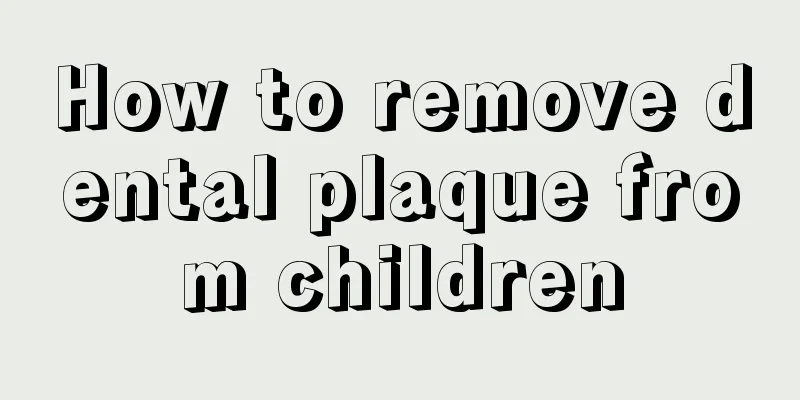How to remove dental plaque from children

|
Dental plaque in children is a relatively common disease. It is often seen in the dental department that if your child has dental plaque, certain treatments must be carried out. If it is not treated for a long time, it may cause the symptoms of dental plaque to worsen and even cause toothache in the child, which will eventually lead to more serious diseases. Therefore, we should pay enough attention to this situation. So, how should children's dental plaque be removed? 1. How is dental plaque formed? (Material basis: saliva + food residue + necrotic cells) The saliva in the mouth contains a large amount of nutrients, which are very easy to adhere to the surface of the teeth. Even if the teeth have just been brushed, a layer of nutrient film will gather again in less than a few minutes, and it will become thicker and thicker. If you encounter someone with poor oral hygiene habits, food residues and necrotic cells will cause more nutrients to adhere to the surface of the teeth. 2. Biological factors (various bacteria) When the surface of the teeth is rich in nutrients, it will attract a large number of bacteria to attach, and the more nutrients there are, the more bacteria will gather. These bacteria mainly include various streptococci and anaerobic bacteria, which will continue to multiply, continuously release various wastes, and continuously expand the range of colonies on the dental surface. Eventually, the mixture of saliva, food debris, necrotic cells, and bacterial communities accumulates, causing yellow or black areas, which are dental plaque, to form on the originally white surface of teeth. If it is not cleaned and removed for a long time, very hard and difficult to remove plaque will accumulate. 3. What are the dangers of dental plaque? (1)Causing disease. The formation of dental plaque indicates that there are a large number of bacteria in the mouth. These bacteria will release a variety of toxins and metabolites in large quantities. When the metabolites and toxins released by the bacteria reach a certain level, they will cause damage to the oral organs, such as caries, oral ulcers, bad breath, tonsillitis, pharyngitis, etc. (2) Affects the appearance. After a long period of accumulation and precipitation, dental plaque will eventually calcify to form very obvious dirt attached to the surface of the teeth. This dirt is hard and very difficult to remove, which will inevitably cause great damage to one's own image during interpersonal communication. When the amount of dental plaque is small, it is difficult to observe with the naked eye and can usually only be displayed using a plaque indicator. 【Operation steps】 Step 1: Apply plaque stain. When applying plaque stain, it is best to apply lip balm to the lips and surrounding skin first so that the stain will not come into contact with these areas. In addition, be careful when operating to avoid getting stains on clothes and other items. Step 2: Rinse your mouth thoroughly and spit out any excess dye. Step 3: Check the residual dye in the mouth. The place where the dye remains in the mouth is where the dental plaque hides! The purple-red area indicates that this is where the dental plaque gathers, and it also indicates that this part needs to be cleaned in the future. Step 4: Cleaning. Now that we have found the enemy, dental plaque sticks to the teeth and mucous membranes like a layer of paste. We must use a toothbrush to rub it continuously to remove it, and the gaps between the teeth must be cleaned with dental floss! |
<<: Can children drink milk when they have a fever?
>>: Baby likes to pick his nose
Recommend
What should I do if my child has crooked teeth?
No matter what stage a child is in, parents will ...
At what age does the baby start to have a stomachache?
Babies who are breastfed often do not defecate fo...
Three month old baby always bites his lips
Many parents are very distressed that their three...
What factors affect children’s vision development?
With the popularity of mobile phones and computer...
What to do if your child has a headache
In life, many children often have headaches. Pare...
What causes a child’s ears to suddenly swell?
If a child's ears suddenly swell, the child w...
Baby Food Encyclopedia
For babies who have just been born, we must pay s...
What to do if a 1-year-old child has diarrhea and vomiting
Every change in the baby after birth is watched b...
What to do if your baby has a runny nose
The health of the baby is an issue that many pare...
Children have fever and itching
Whenever children have a fever, they will feel it...
Black streaks in baby's stool
We all know that babies cannot eat many foods whe...
Symptoms of autism in two-year-olds
Newborn babies are developing in all aspects of t...
Symptoms of psychological disorders in children
Many parents now hold the mentality that as long ...
What to do if your baby has diarrhea when switching to new milk
You should pay special attention when changing yo...
What should six-year-old children pay attention to in their diet when their vision is declining?
As our living standards continue to improve, ther...









